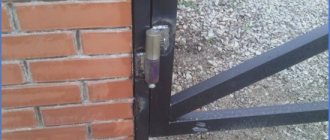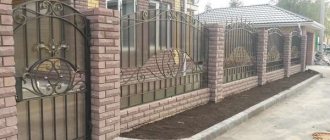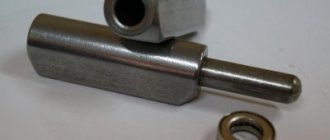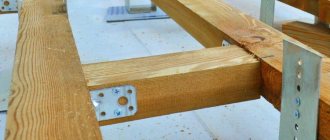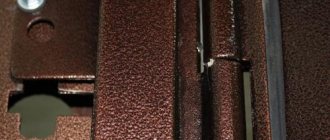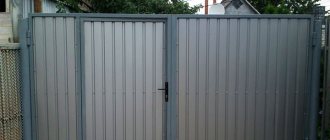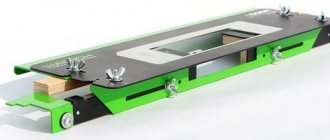Initially, you should know that hinges for wooden gates are divided into universal, right-handed and left-handed. It won’t be difficult to decide on the first ones on the list; they will fit in any case. For the rest, the choice is simple: you need to imagine in which direction the door leaves will open in relation to how to stand in relation to them.
Garage in the village
Choosing the shape of the loops
Modern gate hinges are manufactured in various form factors, which have both advantages and disadvantages. Garage fittings can be classified into three types:
- Cylindrical. The most common choice despite its rather unusual appearance. To install such hinges, it is necessary to use welding, and before welding the hinges, it is necessary to weld the ears for their secure fastening.
- Square. Such hinges are very easily and reliably welded to the base due to the large contact area of the surfaces due to their square shape.
- Hexagonal. Loops that are not widely used in practice, but can still be found on sale. They are not much different from round ones; to weld them, you will also need to pre-weld the ears to install the hinges.
Loops of different shapes
Teardrop-shaped. This shape is typical only for hinges with a bearing. In addition to its aesthetic appearance, this type is distinguished by two undeniable advantages - a uniform welding seam and ease of installation, which are achieved due to its special shape.
Drop-shaped loop section with bearing
Arrow loops. Can be used on both wooden and metal gates. The special shape allows the loop to have a margin of safety, and also gives it a rather colorful appearance.
Types of arrow loops
Of the presented hinge form factors, the best option would be a cylindrical garage hinge with a ball. Despite the need for additional work during installation, such hinges are characterized by good performance characteristics and reliability.
Garage hinge sizes
The purpose of the fasteners is to hold the hinged sashes and ensure their correct opening. In order for them to fulfill their purpose over a long period of time, the parts must meet the following GOST requirements:
- An important factor when choosing fastening elements are the parameters of a large metal structure.
In addition, it is necessary to take into account the materials, fillers and additional equipment of the gate. If the total mass of the partition is 200 kg, and the sheet thickness is more than 4 mm, then fasteners with a diameter of more than 20 mm are used to assemble it. - In order for the block to withstand a one-time impact force of 10 tons, the length of each assembled component must be at least 200 mm. In this case, the circumference of the part is from 30 mm. For private garages, fasteners with indicators of 14×90, 20×120, 20×150, etc. are used. Small models are installed on gates.
Peculiarities
To find hinges for gates, you need to know the main characteristics and parameters. Today, many consumers who choose this design and decide to install it themselves face difficulties when searching for components. The rich selection can confuse every beginner. It is necessary to purchase hinges according to certain parameters, selecting them for a specific gate design.
An important point is the placement of elements. Regarding installation, the hinges must be installed according to the instructions using the appropriate tools.
The material from which the doors are made matters, because they can be wooden, metal, or trimmed with different panels, which affects their weight. If the gate is large, you will need hinges that can withstand heavy loads. Otherwise, they will fail in the near future, and you will have to replace them.
Selecting the appropriate profile and pipes
A corrugated pipe with a cross-section of at least 20 mm is selected for the garage door. A thicker profile for welding is also suitable. This will strengthen the structure and give it additional stability. It should be remembered that increasing the thickness of the metal makes work more difficult and increases the overall weight. Thinner material is inexpensive.
We weld a frame from a profile pipe
Suitable electrodes are selected based on the metal being welded. If you have sufficient work experience, then it is better to weld structural elements with 3 mm thick electrodes.
Assembly and welding of the supporting frame
When the workplace is cleared and everything is prepared, work begins. First of all, they tie around the gate opening, installing a supporting frame in it. It is made from 2 parts.
Cleaning welds
The technology of work includes several stages:
- Measure the dimensions of the opening. In this case, it is necessary to measure accurately, since any deviations will affect the installation of the welded frame.
- Using a grinder, blanks are cut to size from the corner.
- They are laid out evenly and leveled. It is necessary to set the corners of the structure exactly 90 degrees. As a result, you should get a future frame, but not yet welded.
- The joints of the product are secured by welding.
- Check the quality of welding and evenness of the structure. Any deviations found must be eliminated using a hammer. The joints are also thoroughly welded.
- To simplify subsequent assembly, welding beads should not be left. Such places need to be thoroughly cleaned.
The second frame is made in the same way as the first part. Then they are installed in their places. Steel pins 15–20 cm long are driven into the opening slopes and the frame is attached to them.
Frame drawing
All protruding parts are cut off, boiled well, and thoroughly sanded. The frame parts are connected together with metal plates 50–70 mm wide, they are welded every 50–60 cm along the entire length of the opening. Finally, the garage door leaves are made and hung.
If desired, automatic control is installed on the structure. To do this, during the design and manufacture of the structure, it is necessary to provide for the place where the drive will be mounted.
Preparatory work
They start by welding the plates to the hinges. This step can be skipped if you are using ready-made canopies with mounting plates or when mounting them on round poles of small cross-section. The plates are cut from sheet steel using a grinder, choosing sheets with a thickness of at least 5 mm.
Before assembling the hinge, its internal part (the place where the bearing is located) is carefully treated with lubricant, and the area allocated for welding is cleaned of dust and rust. Cook on a horizontal surface. Two plates are laid side by side along the long side with a gap of 2–3 mm. Half of the canopy is placed on top, welded to one of the plates with a continuous seam. A similar operation is performed with the second half. The resulting seams are carefully cleaned.
Important: according to fire safety rules, welding work is carried out either on unpainted or fully painted, dry parts. Paint that is not completely dry can ignite from a spark.
Kinds
Four-hinged hinges come in different modifications, which can be selected depending on the location of the panel relative to the box and the cabinet itself in the room.
Invoice
The canvas attached to this loop is completely perpendicular to the body and covers the stand. Used when the door overlaps the side rail of the cabinet.
Invoice
Insert
The door leaf is perpendicular to the post, but does not overlap its end.
The overhead hinges also differ in the angle of inclination. This is necessary for installing corner cabinet doors. Depending on the difference between the angle of the facade and the perpendicular to the stand, you can select hinges with an opening angle: -25 °, 30 °, 45 °, -45 °, 90 °.
Insert
Transformer
Used to create composite facades from several doors or in cabinets with drawers that are hidden
Most four-hinged hinges are made with a built-in closer. This makes the door movement smooth and silent.
Transformer
Eight-joint
It has all the characteristics of a four-hinged hinge, only without inserting the cup into the facade body. It is attached with self-tapping screws, so it is only suitable for fabrics with a dense texture.
Eight-joint
How to weld the hinges yourself
Welding hinges is not an easy task, especially for beginners. But, if you have patience and desire, you can cope with such work even in the absence of serious experience.
To work you will need the following tools:
- metal tape measure;
- level;
- hammer;
- welding machine;
- Sander;
- special mask;
- gloves for welding work.
Rules:
- When working with a welding machine, you must strictly follow safety rules. A protective mask and gloves must be used.
- In accordance with fire safety standards, welding is prohibited near flammable liquids and objects.
- When hinges are welded to the gate, they need to be lightly “grabbed” by welding.
- Since the hinges are welded to the door leaf, when drawing up the drawing, you need to take into account that the distance from the lower edge of the leaf to the lower hinges, as well as from the upper edge to the upper hinges, must be at least 20 cm. On the wings, the place where the hinges are attached is marked with a pencil.
- Fasteners should be thoroughly lubricated with grease. This measure will protect them from cracking when exposed to high temperatures.
- It is believed that if a match is placed along the edges of the hinges, the door will not jam during welding.
- You need to wedge the doors so that when closed they are level. To level the sashes, use a building level.
Stages of work:
- First, the hinge part located at the bottom is welded. The gate hinge must be fixed in the direction from bottom to top. During the welding process, the electrode should be moved horizontally and with extremely smooth movements.
- After the first seam, the gate leaves must be wedged to check their operation. The hinges are fully welded only after the quality of opening and closing the doors has been checked.
- After welding is completed, the frame must be removed from its hinges, generously lubricated with grease and returned to its place.
- All welding seams must be processed with a grinding machine, and then covered with metal paint.
- Properly welded hinges provide the structure with quick, delay-free opening. You can also close such gates easily - with one movement of your hand.
Additional features:
- During welding, only serviceable equipment should be used. A faulty device must be repaired by a qualified technician.
- The work of welding hinges to the gate cannot be carried out alone.
- It is prohibited to weld on metal whose surface has traces of fresh paint.
- If there are traces of gasoline, fats, or oil on the protective overalls or gloves, they must be changed. The presence of flammable liquids on clothing is considered unacceptable.
- It is prohibited to weld vessels under pressure.
- Do not place rags soaked in oil on the cylinders, as such carelessness always leads to a fire.
Types of welded garage hinges
Loops are available in several variations. Welded ones differ in their design and shape
However, their design is more important
The loops can be made in the form of a cylinder or a polyhedron. If you want to weld them yourself, it is better to take products with edges. It will be more convenient for you to work with them.
Welded hinges, regardless of whether they are cylindrical or polygonal, can have different designs. Let's look at the possible variations of such products:
- The most popular option is a simple hinge. In this case, one hinge body rests on the end of the other body. The opening of the gate occurs due to the rotation of the moving part relative to the stationary one. In this case, a lot of friction occurs. Therefore, opening the gate is quite difficult.
- A safe-type hinge has a ball between the rod and the hole in the hinge body. In this case, the gate opens not due to the rotation of the rod relative to the stationary body, but due to the rotation of the hinge. This reduces the friction of the loops against each other. This makes it easier to open the gate.
- Garage hinges with bearings. In such structures, a bearing is located between the rod and the hole of the hinge halves. This also reduces friction. These gates are very easy to open.
Thus, we can safely say that for heavy garage doors it is better to choose hinges with a ball or hinge. The fact is that thanks to them it will be easier for you to open garage doors.
Choosing material for garage hinges
Hinges for garage doors are made from metal profiles, black steel or low-alloy alloys. When choosing a material for fasteners, it is necessary to take into account the grade of steel of the body so that it can ensure high-quality weldability with the steel frame. Parts made of black steel are welded using electric welding by processing around the perimeter of the body or flange plates. Hinges made of alloyed materials are spot welded using argon or carbon dioxide welding.
There are no significant advantages that make it worthwhile to mount gates on stainless steel hinges, except that they are not subject to corrosion. In addition, the coefficient of friction in these joints is higher than that of carbon steel with standard characteristics.
This is interesting: How to choose wood glue
Gate hinge problem
Such products are manufactured and used for one purpose. It should ensure silent opening and closing of the gate, protect the door from sagging, guarantee easy turns, resist burglary, and cope with different weather conditions.
Of course, a high-quality product must last for many years without losing its original characteristics. Since there are several types of designs on the market, it is important to ensure that the listed requirements are fully met, only then can you make a purchase.
It is recommended to seek help from qualified specialists who can advise which option will be better in your case.
We must not forget that the hinges must have aesthetics and match the design of the entire product . Manufacturers pay special attention to presentation, so you can find beautiful models with carvings and forging elements. In addition, they can be square, cylindrical or hexagonal.
Installing the loop
When assembling furniture, it is best to first install the fastening hinges on the doors, and then proceed to install them on the cabinet. This is explained by the fact that the door is the most movable connection, and it would be correct if you start installation work with this element. Using this method, you will greatly facilitate the assembly process if you decide to screw the door to the cabinet with your own hands. In this case, the door must be mounted in such a way that during operation it is open 45 degrees.
First of all, a hinge cup is installed in the round hole, and then it is necessary to adjust the location of the hinge in relation to the facade. Hinged doors should fit tightly to the facade, but if adjustments are not made during installation, the door will begin to open or its placement will be uneven. The next step, when the cup is installed, is to secure the door to the cabinet:
- holes are marked for attaching the mounting plate;
- the mounting strip is secured in place using furniture screws;
- attach the door to the plane of the cabinet and connect the hinge;
- fasten all the screws, tighten them with a screwdriver;
- adjust the door using the adjusting screw and screwdriver.
This arrangement makes it easier to try on and adjust furniture fasteners.
Several distinctive features of welding hinges to corrugated sheets
Quite often, profiled sheets are used as a material for creating gates or fences. If a person needs to weld hinges to this material, then some factors should be taken into account. It is required to make lintels that must be parallel to the vertical part of the sash.
It is necessary to secure the jumpers in those places where the hinges are welded. They must divide the sash into 3 identical elements. Hinges must be welded to the jumpers. To cover the welding area and jumper, small pieces of corrugated sheeting can be screwed on top. It is better to give preference to thicker loops with a length of more than 1 m.
If the gate is made of corrugated sheets
Hinge for gates made of corrugated sheets
The sequence of welding operations looks like this:
- Make two jumpers, directing them parallel to the long sides of the sash. They are secured with special squares.
- The distance between the jumpers is set so that the sash is divided into three equal parts. Then it is necessary to weld loops to them.
- Corrugated sheeting is screwed on top of the canopies.
Be careful! You can properly strengthen the loops so that there are no negative consequences by adhering to basic rules. You cannot brew with faulty equipment. No welding should be done until the paint is dry. Do not weld in clothing that contains traces of oil, grease or gasoline. Do not hang rags soaked in flammable materials on cylinders.
Varieties
Hinges allow you to smoothly open and close the gate without making a single sound
All types of loops can be divided into three groups:
- classic;
- decorative;
- hidden.
The first ones have a normal appearance, because the consumer encounters them quite often, since they are installed on entrance and interior doors. Even though we are talking about gate hinges, they are not particularly different. In this case, there is one aspect that plays an important role, this is the special treatment of the material, thanks to which the hinges will withstand any weather conditions.
Increased reliability is one of the most important characteristics during hinge production. This element must withstand heavy loads, because the gate is heavy and is also used regularly. Therefore, additional bearings are often installed to improve the data. You can often find hinges without ears on sale, since the consumer can independently weld them to the product, depending on the structure of the system.
Articulated
Hinges are in great demand and this can be reasonably explained. They allow you to easily and smoothly guide the gate and are resistant to breakage, which is an important indicator. Some of the hinges of this device are designed for installation on large gates, as they can withstand heavy loads. Spontaneous opening and closing is excluded if the structure itself is installed correctly and this fitting option is selected.
For the manufacture of hinges, durable and reliable metal is used, which has excellent performance. Heavy gates will last a long time with this installation.
Hidden
They resemble classic ones, but the main advantage is their increased burglary resistance, and for many this is the main indicator. Removing such gates will be problematic and will also take a lot of time.
Decorative
According to the principle of operation, they do not differ from the classic ones, but they look more aesthetically pleasing and can emphasize the design of the gate installation. Hinges can be antique, forged, or in a certain style. Welded structures are strong, reliable and provide safety.
teardrop-shaped
They take their name from the shape of the bearings, which are an integral part of the structure. Such hinges are in demand during the installation of garage and entrance gates, steel doors and even safes. Thanks to the teardrop shape, the problem of uneven movement is solved, so if you have heavy swing gates, this option will be one of the best. When opening, you will not hear creaking or noise, the structure will move smoothly.
Cylindrical
They are suitable for a massive frame where strength and resistance to heavy loads are required. They have support bearings that do their job for a long time. In such hinges the crown will be hidden in the body.
Adjustable
This type of hinge is distinguished by its ability to be adjusted, which is an indispensable advantage in certain situations. Thanks to them, you don’t have to worry about the sashes jamming. As for the cost, it all depends on the variety you have chosen, as well as the manufacturer, because everyone sets their own prices.
Installation recommendations
For square-section posts, it is recommended to always use plates, maintaining a gap of 3–5 mm between the edge of the gate and the support. There are several ways to weld hinges to round posts:
- without the use of mounting plates;
- with a plate only on the sash;
- with a narrow spacer on the side of the post and a full plate on the gate.
Read also: How to attach a vacuum cleaner to an angle grinder
When using spacers, it is possible to increase the gap between the hinge and the support, and the spacer can be placed at an angle. This design is more forgiving of welding flaws, but it looks sloppy.
Sliding structures are in great demand and are offered on the market in a wide range. Products are produced in different variations depending on the manufacturer, structural features and purpose. An integral part of such an installation are the hinges, which play an important role. Therefore, you need to pay special attention to choosing high-quality products that will last a long time, coping with their main task.
Nuances of adjustment
Regardless of what types of furniture hinges are installed, it is necessary to adjust the canopy in three planes. In this case, you will have to disassemble and reassemble all the components of the fastener several times. Adjustment nuances:
- Adjustment in depth is made by pressing the hinge base to the plane of the facade and furniture body. The fasteners are loosened using a screwdriver. This type of adjustment is relevant in rooms where there are uneven floors. The tight fit of the hinge bases to the furniture planes will help smooth out all the nuances.
- Vertical adjustment is made by twisting the oval holes of the canopies. This work should be done every few months, as the door may sag over time under its own weight.
- Horizontal adjustment for hinges is carried out in order to ensure that the doors close tightly together or the door adheres to the wall of the furniture body. Thanks to the correct correction, it is possible to improve the movement of the valves from left to right and vice versa.
Any type of adjustment is best done after the furniture is in place. This will complicate the procedure, especially if the dimensions of the structure are not small, but it will be possible to accurately solve problems associated with uneven floors and walls. If you follow all the recommendations exactly, the installed fittings and furniture will last a long time without repair.
Dimensions
This is an important characteristic that plays a role during product search. Since you are looking for gate hardware, you will have a choice of hinges, the diameter of which can be from 25 to 30 mm. Large ones are suitable for large structures, but it is important to consider the weight of the gate you are installing.
With such a question, it is better to seek professional help or independently find information about what size loops are needed for a particular system.
Large fittings are often used in manufacturing and industrial enterprises where huge gates are installed. For a house, the usual parameters are suitable, but here you need to take into account the weight of the structure.
What should gate hinges be like?
Metal gates are most often installed on garages and fences that protect the perimeter of the area. First of all, they perform security and protective functions, and only then decorative ones. Products in this category can weigh from 200 to 1500 kg. Therefore, in order for the structure to serve well for many years, it is necessary to select only fittings that are suitable in terms of strength.
Drawing with dimensions of gate hinges
Poor quality hinges or hinges that do not fit the gate lead to the following problems:
- cannot withstand the applied load and become deformed;
- the gate begins to sag;
- The doors no longer open easily and close tightly.
Buying high-quality hinges that best fit the gate means:
- provide the gate with all conditions for long-term service;
- forget about creaking and grinding noises when operating the sashes;
- provide the entrance to the yard or garage with maximum protection against burglary.
Modern fittings for garage structures function perfectly in any weather. Permissible temperature range:
- from – 400;
- up to +1200.
Mechanism selection
Main types of garage hinges
The rapid technological process affects many aspects of our lives, and even hinges for wooden gates (as well as metal ones) are no exception. If previously the fittings for garage doors were very simple and monotonous, today you can find many types of different hinges that differ in their features and advantages.
The table shows the main types.
| Hinges. In the middle of the product, made of steel, there is a ball, thanks to which the loop moves. This type will be discussed in more detail below. |
| Cylindrical. This fittings are also called bearing hinges. It is attached to a special support by welding metals. Due to the design features and fastening on the gate, cylindrical hinges with a support bearing are well suited only for swing gates with a small mass - the total load should not be more than 400 kilograms for each hinge. Otherwise, there is a high risk of breakdown. |
| Cylindrical reinforced. These welded hinges are improved versions of the previously discussed hinges - they have a more advanced structure and optimal load distribution. The maximum weight that one such hinge can hold without any consequences is about 600 kilograms, so reinforced cylindrical hinges can be used for installing heavy gates. |
| Through. In the event that garage door hinges for certain reasons cannot be installed by welding or screwing to a surface, through-type hinges are used. To install such fittings in the gate structure, the entire length of the mounting columns is drilled into which part of the hinge is threaded. After this, it is firmly fixed using nuts of a suitable size. Due to this fastening scheme, through garage hinges are designed for a load of no more than 200 kilograms. |
| Invoices. These are the most popular gate hinges among garage owners, which have gained such popularity due to their high reliability, strength and wear resistance. Another advantage of overhead hinges is the complete absence of squeaking when opening and closing the doors. Such fittings completely take over the load from the door leaves and do not allow them to sag. Also, overhead hinges are also burglar-resistant. |
| Forged. This is an old type of garage hinge, which was born many centuries ago and was used to hold wooden gate leaves. Despite this, forged type hinges are often used today, including for creating design solutions. Some modern models of forged hinges are in no way inferior to others. |
Which gate hinges to choose from such a variety? If you are already overwhelmed by the wide range of modern stores, read on to find out the rules of choice.
Why hinge hinges are so good
It should be noted that hinged gate hinges are highly popular. It is largely due to the numerous advantages of such loops, which are listed below:
- Ease, smoothness and noiselessness of turning, subject to regular lubrication.
- Hinges for metal gates are highly resistant to burglary.
- Ability to withstand heavy loads, especially for hinges with a large hinge.
- No chance of spontaneous closing and opening (provided the garage door is installed correctly in a vertical plane).
The positive qualities mentioned above make it possible to install hinge hinges on gates made of corrugated sheets. Thus, the hinges that are installed inside the hinges are made of durable and reliable metals with decent performance characteristics. Thanks to this, not only the possible load on the hinges from heavy door leaves increases, but also their service life.
Cylindrical garage hinges in different sizes
It is important to select the correct number and parameters of hinges based on the weight of the gate door, for example:
- For a lightweight gate made of corrugated sheets, one hinge per hinge with a diameter of 25 mm is sufficient.
- For a standard gate door you will have to choose hinges with hinges with a diameter of 35 mm or more.
- If you plan to install a massive garage door, it is necessary to increase not only the diameter of the hinge, but also the number of such balls in one hinge (up to 2-3 pieces per leaf).
Classification of products according to GOST
Since there are a lot of varieties of hinges and manufacturers try to make them as functional, high-quality, durable and reliable as possible, it is customary to carry out a classification according to which they will be divided into certain groups. Thus, choosing the right one for you will be much easier and the choice will be made better.
According to GOST standards, hinges for swing gates can be of the following varieties:
- Cylindrical with support bearing.
- Cylindrical with reinforced structure.
- Hinges for gates and wickets are through.
- Hinges with the possibility of hidden installation.
- Three-section overhead hinges for gates.
Next, we will look at each of these varieties in more detail so that you understand exactly what each of the varieties is and what features and advantages it has.
Cylindrical with support bearing
This type of suspension has a very standard shape and appearance. They resemble a cylinder, which consists of two parts, one has a pin, and the other has a hole where this pin is installed. But their design is modified with a ball bearing.
Cylindrical with bearing: used for light metal sashes weighing no more than 400 kg. The hinges are attached by welding
On the part where the hole is, a ball bearing is installed inside, which allows the curtain to operate more smoothly with a significantly higher load on them. Very often, a hole is made on the opposite side of the bearing, which is closed with a special plug. By opening it, you can easily lubricate the bearing and improve the movement of the air curtain.
For gates, the best use case would be hinges with four or more bearings for smooth opening and closing.
Very often there are bearing loops in which the bearing is located not inside, but between two parts of the loop. Thus, it turns out that they both glide perfectly along it and significantly facilitate the process of opening or closing the gate leaf.
The disadvantage of this design is the difficulty of lubrication, due to the fact that the gate leaf or wicket must first be lifted in order to apply lubricant inside.
Reinforced gate models
They are considered reinforced due to the fact that they can withstand a significantly greater load than ordinary ones, thanks to the use of more durable metal. Also, a greater load is possible due to the fact that the walls and rod are much thicker, which significantly increases the load-bearing capacity and the maximum possible load on each loop.
If the reinforced loop is equipped with a bearing, then the balls are used with special markings, which shows their increased wear resistance and the maximum pressure that can be applied to them is much higher than that of simple bearings. Thus, on such ball bearings it is possible to wrap very heavy gates without much difficulty.
Through curtains
They are called through because a rod passes through them, which enters one end and protrudes slightly at the other. The simplest type of such loops consists of three elements: a pin for connecting two halves, a right and left loop.
Through hinges: can withstand light weights from 100 to 200 kg.
The loops are assembled according to the type of constructor, on one there is one loop, on the second there are two, through which the rod passes, reliably connecting them. You can also find varieties with the presence of not three, but four, five, six or more elements on each part of the loop.
Also, to simplify work, ball bearings can be installed between some of the hinges, which help work more smoothly and easily.
In order to make disassembling such a loop difficult or even impossible, a special plug is installed at the lower end, which prevents the pin from being removed. Most often it is welded, less often screwed. If such an element is not provided in the design, then a limiter is welded on top of the pin, which will protect it from being removed.
Secret hinges
These curtains have a special design that allows them to be easily hidden and hidden from view when the gate is in the closed position. Most often, the hinge itself is hidden in the sash frame, and is attached to the end part of the support posts and to the frame itself, only from the inside. The advantage of such curtains is that they are very difficult to detect and almost impossible to remove or cut without a special tool.
Canopies for technical sectional gates are most in demand in the case of a large mass of leaves.
Three-section industrial
They are similar in design to through ones, but are more cylindrical. The middle part of such loops is equipped with two pins that are directed in opposite directions. Empty cylinders are put on them on both sides and welded to the posts, after which it is impossible to remove such a loop without cutting.
Read also: The best glue for plastic
Process technology
Installing plates
Many inexperienced welders have certain doubts about the possibility of welding cylindrical hinges to a flat surface. There is no doubt that this procedure with round loops is much easier to perform than with square and hexagonal ones.
In order to properly weld round hinges, you need to take care of installing the plates - they are welded to the hinges themselves using a welding machine. It is necessary to do this with an even seam. By welding the plates to the hinges, a convenient platform is created for installing the hinges on the gate itself. These irreplaceable elements are selected in accordance with the weight of the gate and the strength of the material from which the plates are made.
Reinforcing loops with plaits
Some craftsmen weld hinges without using plates. This option is also possible, but thanks to their use the fastening is more reliable.
Installing gates
Before welding the hinges on the gate, the gate leaves must be correctly positioned in the opening of the garage or fence. The complexity of the procedure lies in the fact that the gate should be placed in the opening before the hinges are welded, that is, virtually by eye. To position the gate as accurately as possible, you need to use a building level and a lot of patience. Adjustment of the gate position should be carried out as many times as necessary until the gates are in a level position. Only after precise placement can welding be carried out.
Gate hinges with welded plates
We weld the hinges to the gate
Now let's figure out how to properly weld the hinges on the gate. Despite the apparent complexity of this procedure, it is quite possible to perform it with the proper skill and patience. Welding hinges on garage doors is carried out in several sequential steps listed below:
- Lubricate garage hinges with welded plates with grease to ensure their smooth movement after installation. Also prepare thin linings for the hinges - their thickness should not exceed 5 mm. They are necessary primarily for round hinges.
- Make the correct markings of the fabric for the loops. So, it is necessary to mark indentations from the edges of 25-30 cm. The markings are applied with a construction pencil.
Prepared plates
- Weld the hinges to the door leaf. To do this, first weld the bayonet parts of the hinges, at first only slightly grabbing them by welding, then weld the metal from the bottom to the top, while ensuring the most even seam.
- After welding the first seam on all hinges, you need to use a level (it is better to use a construction level for these purposes) to check the correct opening and closing of the gate. If no defects are found, you can continue.
Iron loop welded to the gate
- After the installation of hinges on the gate by welding is completed, you need to carefully process all welds with a grinding machine. The last stage is painting the gates and hinges in any color you like. That's all!
As you can see, attaching the gate hinges yourself is not such a difficult task, impossible to do at home. It is enough to have the necessary equipment at hand and strictly follow the recommendations for action specified in this manual.
If you are installing garage door hinges, weld them in such a way that the doors open outward. Otherwise, big problems will arise after the snowfall.
Required tools and materials
Before welding the hinges onto the gate, their type is determined. They are hinged, semi-hinged and hinged. For heavy gates, it is recommended to use large hinge hinges: the bearing they contain reduces friction inside the canopy, increasing its service life and making it easier to open the door. It is most convenient to work with parts with a round and hexagonal cross-section; it is more difficult to work with canopies with a square cross-section.
The larger the mount, the higher its load-bearing capacity. Therefore, a part with a safety margin is first selected: weak canopies will deform and collapse under load. But also the requirements for the strength of the hinges are higher for those gates that are used more often - it is correct to weld massive hinges even on a small gate if it is constantly being opened and closed. Only high-strength alloys are chosen as the material for canopies.
To weld the hinges in place, plates are used - metal plates attached to the top and bottom of the canopies to ensure a reliable connection. The height of one plate should be equal to the height of the loop, the width is selected based on the installation conditions.
For example, for a garage door 2.5 x 2.5 m, elements of 80 x 80 mm are used.
Hinges are sold in hardware stores. Factory assembled products are supplied with plates already welded. However, it is possible to manufacture an element according to a drawing in a private workshop.
Having decided on future nodes, you can begin preparing for work. To do this you will need the following tools:
- level;
- roulette;
- hammer;
- mounting pads (boards, bricks, nuts and bolts);
- grinding machine (“grinder”);
- metal brush;
- lubricant (solidol or lithol);
- welding machine;
- dry electrodes with a diameter of at least three mm;
- individual protection means.
When carrying out welding work, the contractor is obliged to comply with safety requirements. Forbidden:
- Carry out work on a faulty welding machine.
- Connect the equipment to an ungrounded power source or to a power source of improper power.
- Weld near flammable materials and explosive substances.
- Work without personal protective equipment, wearing flammable clothing. Personal protective equipment includes: mask, mittens (or leggings), shoes. It is recommended to wear a welding suit while working.
Nuances of proper installation
How to properly attach hinges, forged hinges and other structures? You just need to follow some recommendations and act according to the given algorithm:
- preparation of tools - hammer, chisel, grinder and welding unit. You will need a building level, a screwdriver and a tape measure. You need to have a sketch in front of you, and, of course, you should not forget about the safety of the work;
- if you need to weld the plates separately, then it is worth considering that the load on them must be evenly distributed;
- make markings for attaching hinges to the gate posts and to the leaves;
- how to attach the hinges? It is enough to use self-tapping screws for these purposes;
- Hanging elements is quite simple, but it is better to carry out this process with at least two people.
Village yard
Hinges for garage doors: popular types
Not every product model is suitable for customers, since the choice of product should be made based on the specifics of the movable sashes, their dimensions, weight and material used during production. In practice, several particularly popular types of garage hinges are used, which can be divided into the following groups:
- hinged;
- cylindrical regular;
- cylindrical reinforced;
- forged;
- invoices;
- end-to-end.
A popular, but very expensive option is reinforced cylindrical garage hinges, which have all the necessary indicators of reliability and convenience. Their shape is designed in such a way as to efficiently distribute the load exerted on the mechanism during operation of the gate, without interfering with the smooth opening of the leaves. Such hinges can withstand a weight of up to 600 kilograms, so the products are suitable for any purpose: for installation on household or heavy industrial structures.
In second place in popularity are through hinges for gates, which are installed using special fasteners. If in the first case we need to use a welding procedure, then such hinges can be freely attached to predetermined places, prepared using a conventional drill. Due to the unique fastening procedure, through gate hinges can withstand loads of up to 200 kilograms, which significantly reduces the scope of their possible use.
Overhead hinges for gates have high burglary resistance, which have gained wide popularity among consumers due to ease of installation and complete absence of squeaking during operation. Overhead mechanisms do not allow the gate leaves to sag, and you do not have to constantly lubricate them, which is especially appreciated by the owners of buildings built in difficult climatic conditions with high levels of precipitation.
Forged elements of garage doors are optimal for those customers who, when placing an order, pay the main attention to the appearance of the product they like. Such products came to us from ancient times, when wooden garden gates were equipped with forged hinges, and the metal performed its function perfectly for a long time
Now they can also be used for installing swing-type metal garage doors, but such hinges will not be able to withstand heavy loads. By the way, forged hinges are most often used when designing gates and entrance doors, which are produced in a wide range of designs and shapes.
Hinged and conventional cylindrical hinges have a particularly attractive price, but do not particularly stand out among their analogues. Such mechanisms can be used for both a home garage and garden gate structures, especially if you are trying to invest on a limited financial budget.
Choosing the most suitable type of hinges on your own is quite difficult, since there are a number of factors that cannot be analyzed without specific knowledge in the field of manufacturing gates and moving components. Accordingly, if you do not want to make a mistake with the purchase, it is recommended to enlist the help of qualified craftsmen who can conduct a thorough analysis of the compliance of the loops with many technical indicators.
Requirements
Gate hinges are offered in different types, each of which differs in its design and purpose. All products must comply with GOST according to their characteristics. Cylindrical hinges, which have support bearings, are suitable for medium-sized gates. According to state standards, they can only be used with a load that does not exceed 400 kg.
Reinforced fittings are also made with a support bearing connected to two plates. The power capabilities of such loops vary from 125 to 600 kg. They are made from high-strength steel that is pre-treated to provide corrosion protection.
Through hinges are suitable for light loads up to 200kg. According to the GOST standard, such fittings are fixed using a special method: you will need to make a hole in the rack to attach the curtain using nuts.
Attaching hinges to glass doors
With the growing popularity of tempered glass furniture, the range of fittings that can work properly with this material has also expanded. Despite the increased strength indicators compared to traditional glass, tempered glass is still much more vulnerable to mechanical stress than wood and chipboard panels. Therefore, for doors made of this material, certain types of hinges with a fundamentally different type of fastening element are produced. The first difference between these mechanisms is their increased strength and load-carrying capacity due to the high weight of the glass. The following metals are used as the basis for glass door hinges:
- Bronze;
- Aluminum;
- Zinc alloy;
- Stainless steel alloy.
According to the principle of fastening, hinge mechanisms can be overhead or mortise. The latter traditionally require the creation of holes for fixing screws, when the former rely on holding the glass facade by applying high pressure to it. In this case, overhead hinges can work on the principle of clamping with platforms on both sides of the glass door or using fixing screws that press the facade inside the hinge mechanism.
